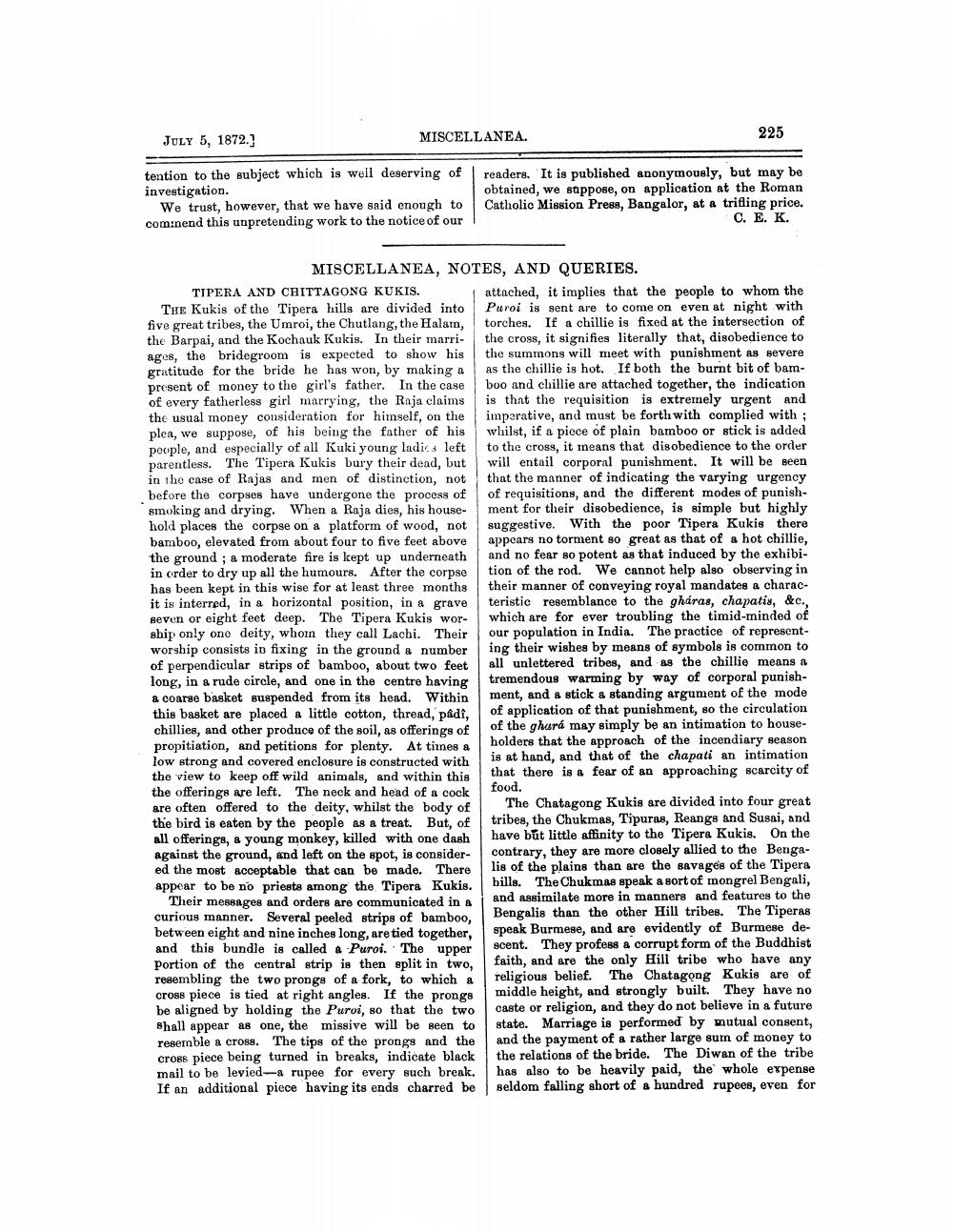________________
MISCELLANEA.
JULY 5, 1872.]
tention to the subject which is well deserving of investigation.
We trust, however, that we have said enough to commend this unpretending work to the notice of our
MISCELLANEA, NOTES, AND QUERIES.
TIPERA AND CHITTAGONG KUKIS. THE Kukis of the Tipera hills are divided into five great tribes, the Umroi, the Chutlang, the Halam, the Barpai, and the Kochauk Kukis. In their marriages, the bridegroom is expected to show his gratitude for the bride he has won, by making a present of money to the girl's father. In the case of every fatherless girl marrying, the Raja claims the usual money consideration for himself, on the plea, we suppose, of his being the father of his people, and especially of all Kuki young ladies left parentless. The Tipera Kukis bury their dead, but in the case of Rajas and men of distinction, not before the corpses have undergone the process of smoking and drying. When a Raja dies, his household places the corpse on a platform of wood, not bamboo, elevated from about four to five feet above the ground; a moderate fire is kept up underneath in order to dry up all the humours. After the corpse has been kept in this wise for at least three months it is interred, in a horizontal position, in a grave seven or eight feet deep. The Tipera Kukis worship only one deity, whom they call Lachi. Their worship consists in fixing in the ground a number of perpendicular strips of bamboo, about two feet long, in a rude circle, and one in the centre having a coarse basket suspended from its head. Within this basket are placed a little cotton, thread, pâdî, chillies, and other produce of the soil, as offerings of propitiation, and petitions for plenty. At times a low strong and covered enclosure is constructed with the view to keep off wild animals, and within this the offerings are left. The neck and head of a cock are often offered to the deity, whilst the body of the bird is eaten by the people as a treat. But, of all offerings, a young monkey, killed with one dash against the ground, and left on the spot, is considered the most acceptable that can be made. There appear to be no priests among the Tipera Kukis.
Their messages and orders are communicated in a curious manner. Several peeled strips of bamboo, between eight and nine inches long, are tied together, and this bundle is called a Puroi. The upper Portion of the central strip is then split in two, resembling the two prongs of a fork, to which a cross piece is tied at right angles. If the prongs be aligned by holding the Puroi, so that the two shall appear as one, the missive will be seen to resemble a cross. The tips of the prongs and the cross piece being turned in breaks, indicate black mail to be levied-a rupee for every such break. If an additional piece having its ends charred be
225
readers. It is published anonymously, but may be obtained, we suppose, on application at the Roman Catholic Mission Press, Bangalor, at a trifling price. C. E. K.
attached, it implies that the people to whom the Puroi is sent are to come on even at night with torches. If a chillie is fixed at the intersection of the cross, it signifies literally that, disobedience to the summons will meet with punishment as severe as the chillie is hot. If both the burnt bit of bamboo and chillie are attached together, the indication is that the requisition is extremely urgent and imperative, and must be forth with complied with ; whilst, if a piece of plain bamboo or stick is added to the cross, it means that disobedience to the order will entail corporal punishment. It will be seen that the manner of indicating the varying urgency of requisitions, and the different modes of punishment for their disobedience, is simple but highly suggestive. With the poor Tipera Kukis there appears no torment so great as that of a hot chillie, and no fear so potent as that induced by the exhibition of the rod. We cannot help also observing in their manner of conveying royal mandates a characteristic resemblance to the gháras, chapatis, &c., which are for ever troubling the timid-minded of our population in India. The practice of representing their wishes by means of symbols is common to all unlettered tribes, and as the chillie means a tremendous warming by way of corporal punishment, and a stick a standing argument of the mode of application of that punishment, so the circulation of the ghará may simply be an intimation to householders that the approach of the incendiary season is at hand, and that of the chapati an intimation that there is a fear of an approaching scarcity of food.
The Chatagong Kukis are divided into four great tribes, the Chukmas, Tipuras, Reangs and Susai, and have but little affinity to the Tipera Kukis. On the contrary, they are more closely allied to the Bengalis of the plains than are the savages of the Tipera hills. The Chukmas speak a sort of mongrel Bengali, and assimilate more in manners and features to the Bengalis than the other Hill tribes. The Tiperas speak Burmese, and are evidently of Burmese descent. They profess a corrupt form of the Buddhist faith, and are the only Hill tribe who have any religious belief. The Chatagong Kukis are of middle height, and strongly built. They have no caste or religion, and they do not believe in a future state. Marriage is performed by mutual consent, and the payment of a rather large sum of money to the relations of the bride. The Diwan of the tribe has also to be heavily paid, the whole expense seldom falling short of a hundred rupees, even for




